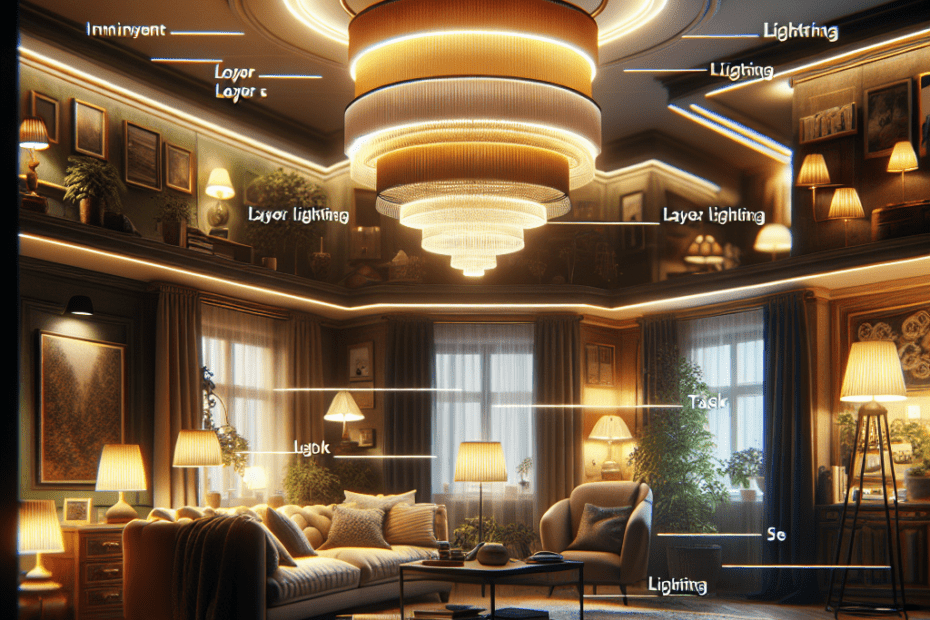“`html
Introduction to Layered Lighting in Design
Layered lighting is an essential component for creating a cozy and well-lit home environment. It involves using different sources of light to build a harmonious and functional space. This method not only enhances the visual appeal of a room but also meets the varying lighting needs of each activity. Many home designers and decorators emphasize the importance of layered lighting in design to evoke the desired mood and atmosphere.
According to a survey by the Home Lighting Association, 76% of homeowners found that layered lighting significantly improved the functionality and aesthetics of their living spaces. With this in mind, the following sections explore systems and techniques within layered lighting in design to help achieve these results in one’s home.
Understanding the Concept of Layered Lighting
Layered lighting isn’t just about placing lamps or installing fixtures; it’s about strategically combining various light sources. There are three main types of lighting to consider:
- Ambient Lighting: This is the primary source of light in a room, often from ceiling fixtures or large lamps. It sets the overall lighting tone.
- Task Lighting: As the name suggests, this lighting is for specific tasks such as reading, cooking, or working. Examples include desk lamps or under-cabinet lights in the kitchen.
- Accent Lighting: Used to highlight specific objects or architectural features. Think spotlights, track lights, or wall sconces for artwork.
Step-by-Step Guide to Implementing Layered Lighting
1. Evaluating Your Space
Before adding new lighting, it is important to assess the current design and understand the natural light available. They should take note of dark corners or areas that require more illumination. Consider the colors and textures in the room, as they affect how light is reflected and absorbed.
2. Adding Ambient Lighting
Start by securing a reliable source of ambient lighting. For most spaces, this can be overhead lighting. Pendants, chandeliers, or flush-mounted fixtures should be selected based on room size and ceiling height. A good rule to remember is that brighter isn’t always better; softer light can create a more inviting atmosphere.
3. Incorporating Task Lighting
Once the room has adequate ambient lighting, addressing specific activities comes next. Task lighting should focus on areas such as bedside tables, kitchen countertops, or study areas. This type of lighting is typically brighter and more concentrated to support detailed tasks.
4. Using Accent Lighting
The final touch is adding accent lighting. This type of lighting plays a great role in elevating the aesthetic appeal. It can highlight artwork, architectural details, or focal points in the room. They may consider LED strips or spotlights to make these features pop.
Tips for Successful Layered Lighting
While understanding the types of lighting is crucial, knowing how to combine them effectively is just as important. Here are a few tips:
- Dimmers: Incorporating dimmers allows them to adjust the brightness according to their needs or mood.
- Color Temperature: Using bulbs with a warm color temperature (around 2700K) is advisable to create a cozy ambiance. They can consider cooler hues for task lighting to mimic daylight.
- Technology: Smart lighting systems allow flexibility and control, with numerous light settings available at the tap of a button or voice command.
Statistics on Layered Lighting
| Aspect | Statistics |
|---|---|
| Homeowners Satisfied with Layered Lighting | 76% (Source: Home Lighting Association) |
| Preference for Smart Lighting Systems | 68% (Source: Smart Home Study 2023) |
| Improved Room Appeal with Accent Lights | 65% (Source: Interior Design Journal) |
Key Takeaways
- Layered lighting enhances both functionality and aesthetics of home spaces.
- There are three main types: ambient, task, and accent lighting.
- A careful evaluation of the space and activities can guide effective light placement.
- Tools like dimmers, smart lights, and correct color temperatures contribute to achieving a cozy atmosphere.
FAQ
- What is layered lighting in design?
Layered lighting uses different types of light sources together to create a more cohesive and functional space.
- How can ambient lighting be achieved?
Ambient lighting can be installed using ceiling fixtures such as chandeliers or pendant lights to provide overall illumination.
- What role does task lighting play in my home?
Task lighting provides the necessary illumination for specific tasks like reading, cooking, or working at a desk.
- Why is accent lighting important?
Accent lighting is used to highlight key features, artwork, or architectural details to enhance the room’s character.
- Can I control lighting with technology?
Yes, smart lighting systems enable you to adjust brightness and color, often with remote controls or voice commands.
“`
